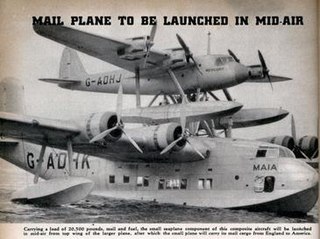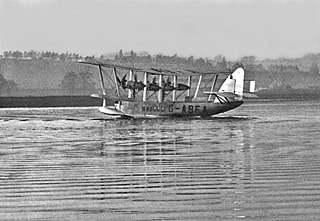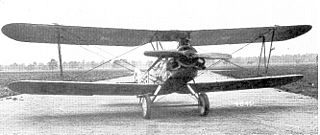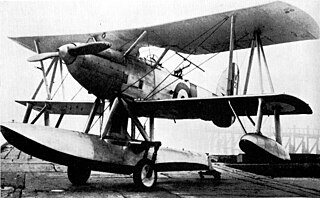
The Short S.14 Sarafand was a British biplane flying boat built by Short Brothers. It was planned as a general reconnaissance aircraft for military service. When it was built in 1932 it was the largest aeroplane in the United Kingdom.

The Short SB.4 Sherpa was an experimental aircraft designed and produced by the British aircraft manufacturer Short Brothers. Only a single example was ever produced.

The Short Mayo Composite was a piggy-back long-range seaplane/flying boat combination produced by Short Brothers to provide a reliable long-range air transport service to North America and, potentially, to other distant places in the British Empire and the Commonwealth.

The Short Springbok was a two-seat, all-metal reconnaissance biplane produced for the British Air Ministry in the 1920s. All together six aircraft of the Springbok design were built but none entered service with the armed forces.

The Short L.17 Scylla was a British four-engined 39-seat biplane airliner designed and built by Short Brothers at the request of Imperial Airways to supplement the Handley Page H.P.42 fleet already in service after Handley Page quoted an excessive price for two additional H.P.42s. They were ordered in 1933.

The Short S.17 Kent was a British four-engined 15-seat biplane luxury flying boat airliner, designed and built by Shorts to meet a requirement from Imperial Airways for an aircraft with greater range than the Short Calcutta. The new aircraft was to have sufficient range to fly the stage from Mirabella, Crete, to Alexandria in Egypt without the need for refuelling stops in Italian colonial territory due to a political row which had led the Italian Government to ban British aircraft from its ports.

The Short S.16 Scion and Scion II were 1930s British two-engine, cantilever monoplanes built by Short Brothers and by Pobjoy Airmotors and Aircraft Ltd. in Rochester, Kent between 1933 and 1937. Altogether 22 Scion/Scion II aircraft were built and they provided useful service to operators working from small airstrips/water courses in many parts of the globe, including Europe, the Near and Middle East, Sierra Leone, Papua New Guinea and Australia. Many were impressed into the Royal Air Force during the Second World War, providing pilot ferry services, anti-aircraft co-operation and radar calibration duties. Of the civilian Scions, at least two were still operating in Australia in 1966, one having been re-engined with de Havilland Gipsy Minor engines.

The Bristol Taxiplane and Bristol Primary Trainer were British single-engine biplane light aircraft built by the Bristol Aeroplane Company in the early 1920s. A total of 28 were built, being mainly used as trainers.

The Short S.8/8 Rangoon was a 1930s British three-engined biplane flying boat, designed and built by Short Brothers for the Royal Air Force.

The Bristol Gordon England biplanes were a series of early British military biplane aircraft designed by Eric Gordon England for the Bristol Aeroplane Company that first flew in 1912. Designed for easy ground transport, the aircraft could be quickly disassembled.
The Bristol Type 91 Brownie was a light sports aircraft produced in the United Kingdom by the Bristol Aeroplane Company in 1924. It was a low-wing cantilever monoplane aircraft of conventional configuration with fixed tailskid undercarriage. The pilot and passenger sat in tandem open cockpits. It won the £1,000 pound prize for second place at the Lympne light aircraft trials in October 1924.

The Short Silver Streak was the first British all-metal aircraft. It was designed and built by Short Brothers at Rochester, Kent, England. Although Flight magazine claimed that it was the first instance of stressed skin construction in the world, it was preceded by a number of Dornier designs, including the Dornier-Zeppelin D.I, which was ordered into production.
The Gnosspelius Gull was a 1920s British experimental ultra-light monoplane designed by Major O.T. Gnosspelius and built by Short Brothers at Rochester for the 1923 Lympne light aircraft trials.

The Bristol Seely was entered into an Air Ministry competition for safe civil aeroplanes held in 1920. It was a single-engine biplane with accommodation for one passenger. After the competition, the single Seely was used as a testbed for the Bristol Jupiter engine development programme.

The Vickers Viget was Vickers' entrant for the first Lympne light aircraft competition, held in 1923. It was a single-seat, single-engined biplane with folding wings.
The Short S.1 Cockle was a single-seat sport monoplane flying boat, with a novel monocoque duralumin hull. It was underpowered and so did not leave the water easily, but it proved that watertight and corrosion-resistant hulls could be built from metal.
The Beardmore Wee Bee was a single-engined monoplane built only once and specifically for the Lympne two-seat light aircraft trials held in the United Kingdom in 1924. This plane won the major prize.

The Cranwell CLA.3 was a parasol winged single-engined, single-seat British aircraft built to compete in the Lympne air races of 1925. It was designed and built by an amateur group drawn from staff and pupils at the RAF College Cranwell. Though it won one prize and set a Class record, only one CLA.3 was made.
The Short S.6 Sturgeon was a prototype single-engined biplane naval reconnaissance aircraft, built to an Air Ministry specification but mostly intended as a demonstrator of the corrosion resistance of duralumin aircraft structures. Two were made.

The Short Gurnard was a single-engined two-seat biplane naval fighter, built in the United Kingdom to an Air Ministry specification in 1929. It failed to win production orders and only two flew.
















